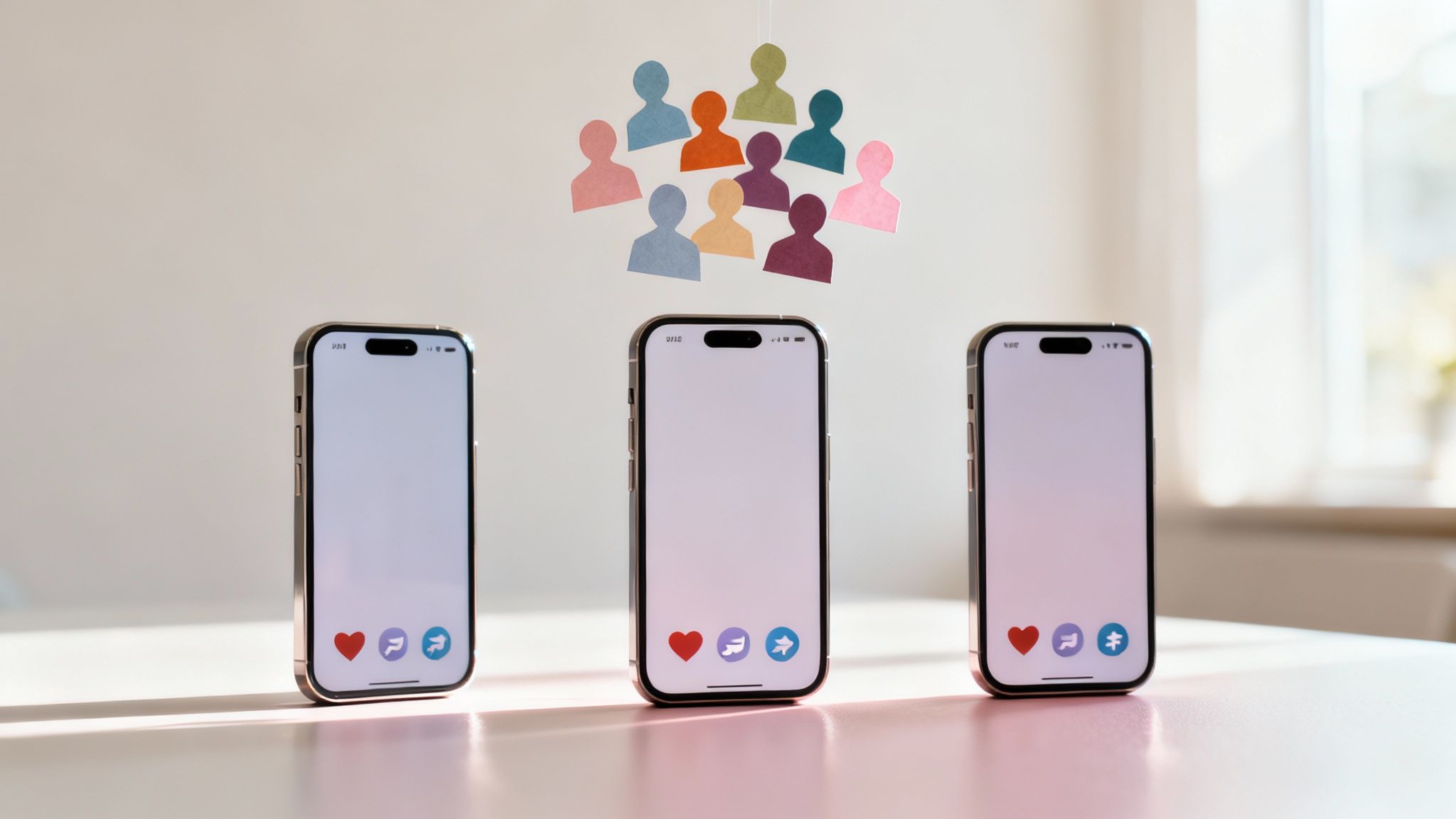Feeling overwhelmed by digital marketing? You're not alone. It's easy to get lost in a sea of jargon and complicated advice, but understanding the core tactics is simpler than you think. The key is to see how successful campaigns actually work behind the scenes. This guide cuts through the noise and provides a clear, actionable look at proven methods.
We're breaking down 12 powerful examples of digital marketing strategies, showing you not just what they are, but exactly how real businesses use them to get real results. We will look at the specific tactics, reveal the strategic thinking, and provide practical takeaways you can apply directly to your own business.
Forget vague theories and generic success stories. This article is your blueprint for effective marketing. Whether you're a local shop owner, an e-commerce entrepreneur, or a startup founder, you'll discover strategies to connect with more customers, build a stronger brand, and grow your bottom line. We'll explore everything from Content Marketing and SEO to Influencer Marketing and Community Building, giving you the practical insights needed to make smart, impactful decisions. Let's dive into the strategies that truly work.
1. Content Marketing
Content marketing is the practice of creating and sharing valuable, relevant, and consistent content to attract and keep a specific audience. Instead of directly pitching your products or services, you provide genuinely useful information that solves your audience's problems. This approach is one of the most foundational examples of digital marketing strategies because it builds trust and establishes your brand as an industry authority, naturally leading to customer loyalty and sales over time.

This strategy works by positioning your business as a go-to resource. When customers need help, they remember the brand that provided free, high-quality advice through blog posts, videos, or guides.
Real-World Example: HubSpot's Educational Content
HubSpot, a marketing and sales software company, built its entire business on content marketing. It offers a massive, free library of blogs, e-books, templates, and courses covering every imaginable marketing and sales topic. By providing immense value upfront, HubSpot becomes an indispensable resource for its target audience of marketing and sales professionals.
This strategy nurtures potential customers by educating them, making a future purchase of HubSpot's software feel like a natural next step rather than a hard sell.
Actionable Takeaways for Your Business
- Identify Pain Points: Use keyword research and customer feedback to discover what questions your audience is asking.
- Create Pillar Content: Develop a comprehensive guide or resource on a core topic, then create smaller, related content like blog posts or social media updates that link back to it.
- Focus on Value, Not Sales: Make sure most of your content is educational or entertaining. The rest can gently guide readers toward your products.
- Maintain Consistency: Set up and stick to a publishing schedule to keep your audience engaged and show reliability to search engines.
2. Search Engine Optimization (SEO)
Search Engine Optimization (SEO) is the process of improving your website to increase its visibility when people search for products or services related to your business in search engines like Google. By optimizing for keywords, site speed, and user experience, SEO helps attract high-quality free traffic. This is a crucial example of digital marketing strategies because it drives targeted visitors to your site without you paying for each click, building long-term, sustainable growth.

This strategy works by showing search engines that your content is the most relevant and authoritative answer to a user's question, earning you a top spot in search results.
Real-World Example: Ahrefs' In-Depth Guides
Ahrefs, an SEO software company, is a master of SEO execution. Instead of publishing content daily, the site focuses on creating extremely in-depth, high-value guides and case studies that target very specific, competitive keywords like "on-page SEO." These comprehensive resources naturally attract links from other authoritative sites, which is a key ranking factor for Google.
This "content-first" approach positions Ahrefs as a definitive industry leader, ensuring it ranks at the top for valuable search terms and attracts a highly qualified audience of marketing professionals.
Actionable Takeaways for Your Business
- Focus on User Intent: Understand why someone is searching for a term and create content that directly solves their problem.
- Prioritize Technical Health: Ensure your website is fast, mobile-friendly, and secure. These are foundational elements for ranking.
- Build Quality Backlinks: Earn links from reputable websites in your industry through guest posting or creating link-worthy content.
- Optimize On-Page Elements: Use your target keywords in page titles, headings, and throughout your content in a natural way.
3. Social Media Marketing
Social media marketing uses platforms like Facebook, Instagram, and LinkedIn to build brand awareness, engage with audiences, and drive sales. Instead of just broadcasting messages, it creates a two-way conversation with customers, which helps build community and loyalty. This direct line to your audience makes it one of the most dynamic examples of digital marketing strategies available today.

This strategy works by meeting customers where they spend their time online, using a mix of organic content, paid ads, and community management to build relationships. For an in-depth understanding of how to craft a successful approach, consult this comprehensive social media marketing strategy playbook.
Real-World Example: Wendy's Witty Twitter Engagement
Wendy's changed its brand image from a typical fast-food chain to a witty, pop-culture-savvy personality through its Twitter presence. By roasting competitors and engaging in humorous banter with followers, Wendy's created a voice that felt authentic and entertaining. This bold approach generated massive free reach and media attention.
Their success shows that a strong, unique brand voice can turn a social media profile into a powerful marketing asset, driving brand recognition and affinity far more effectively than traditional advertising.
Actionable Takeaways for Your Business
- Define Your Voice: Decide on a brand personality. Are you helpful, funny, professional, or inspiring? Keep it consistent.
- Tailor Content: Adapt your message for each platform. What works on LinkedIn (professional insights) will not work on TikTok (short, entertaining videos).
- Engage Authentically: Respond to comments and messages promptly. Don't just post and disappear; build a real community.
- Use Analytics: Track metrics like engagement rate and reach to understand what content connects with your audience, then create more of it. Learn more about creating engaging social media content on digitallotusmarketing.com.
4. Email Marketing
Email marketing is the process of sending targeted commercial messages to a list of subscribers who have opted to receive them. Far from being outdated, it remains one of the most effective and high-return examples of digital marketing strategies because it allows for direct, personalized communication with an engaged audience. This strategy excels at nurturing leads, promoting products, and building lasting customer relationships.
This direct line of communication helps you stay top-of-mind, driving repeat business and fostering loyalty by delivering relevant content straight to your customers' inboxes.
Real-World Example: Grammarly’s Onboarding Sequence
Grammarly, the popular writing assistant tool, masters email marketing with its user onboarding sequence. When a new user signs up, they receive a series of emails designed to educate and encourage product usage. These emails include writing tips, highlight specific features, and provide personalized weekly stats on their writing activity.
This approach doesn't just sell a product; it demonstrates its value and integrates the tool into the user's daily routine, turning free users into loyal, paying subscribers.
Actionable Takeaways for Your Business
- Segment Your Audience: Group subscribers based on their behavior, interests, or purchase history to send highly relevant messages.
- Automate Welcome Sequences: Create an automated email series to welcome new subscribers, introduce your brand, and highlight your value proposition.
- Craft Compelling Subject Lines: A great email is useless if it isn't opened. Use curiosity, urgency, or personalization to boost open rates.
- Offer Exclusive Value: Provide your email list with exclusive discounts, early access to products, or unique content to make them feel valued.
5. Pay-Per-Click (PPC) Advertising
Pay-Per-Click (PPC) advertising is a model of internet marketing where advertisers pay a fee each time one of their ads is clicked. Essentially, it is a way of buying visits to your site rather than trying to "earn" those visits organically. This strategy is one of the most powerful examples of digital marketing strategies because it offers immediate visibility and highly measurable results, allowing businesses to target specific demographics and keywords with precision.
This strategy works by placing your ads on platforms like Google or Facebook, ensuring you appear in front of potential customers at the exact moment they are searching for what you offer.
Real-World Example: Airbnb's Strategic Bidding
Airbnb uses PPC advertising not just for brand awareness but to capture users with high booking intent. They bid on non-branded keywords like "apartments in paris" as well as long-tail keywords like "family-friendly cabin with hot tub near asheville." This allows them to intercept travelers at different stages of their planning process.
By creating ad copy and landing pages that match the user’s specific search query, Airbnb increases relevance and their Quality Score, which lowers their cost-per-click and improves ad positioning.
Actionable Takeaways for Your Business
- Create Dedicated Landing Pages: Don't send PPC traffic to your homepage. Create a specific landing page for each campaign that directly matches the ad's promise.
- Use Negative Keywords: Actively add negative keywords to your campaigns to stop your ads from showing for irrelevant searches, which saves you money.
- Focus on Ad Relevance: Write compelling ad copy that speaks directly to the user's search intent. Higher relevance leads to a better Quality Score and lower costs.
- Track Everything: Implement conversion tracking from day one to measure exactly what's working and calculate your return on ad spend.
6. Influencer Marketing
Influencer marketing is the strategy of collaborating with individuals who have a dedicated social media following to promote your products or services. Instead of advertising directly to a large group, you leverage the trust and credibility an influencer has built with their audience. This approach is one of the most effective examples of digital marketing strategies for reaching niche communities and driving authentic engagement.
This strategy works because it feels less like a traditional ad and more like a trusted recommendation from a friend. When a follower's admired influencer uses a product, it adds a layer of social proof that can be highly persuasive.
Real-World Example: Gymshark's Athlete Community
Gymshark, a fitness apparel brand, grew its business by building a community of fitness influencers and athletes. Instead of one-off paid posts, they established long-term partnerships, treating their influencers as brand ambassadors. These creators, from elite bodybuilders to popular fitness enthusiasts, integrate Gymshark apparel into their daily content naturally.
This community-focused approach makes the brand feel authentic and aspirational. Followers see their fitness idols consistently wearing Gymshark, which builds immense brand loyalty and drives sales far more effectively than a standard advertisement.
Actionable Takeaways for Your Business
- Prioritize Engagement Over Followers: A micro-influencer with a highly engaged audience is often more valuable than a mega-influencer with passive followers.
- Align on Values: Partner with creators whose personal brand and audience demographics genuinely match your own.
- Grant Creative Freedom: Provide clear guidelines but allow the influencer to create content in their own unique voice for maximum authenticity.
- Track Your ROI: Use unique discount codes or trackable affiliate links to measure the direct sales generated from each collaboration.
7. Affiliate Marketing
Affiliate marketing is a performance-based strategy where a business pays third-party publishers, or "affiliates," for generating traffic or sales. Instead of paying for ad space upfront, you only pay a commission when a specific action, like a purchase, is completed. This model is one of the most cost-effective examples of digital marketing strategies because it minimizes risk and leverages the trusted voice of others to promote your brand.
This strategy works by incentivizing bloggers, influencers, and content creators to recommend your products to their established audiences, creating a powerful and authentic sales channel.
Real-World Example: Bluehost's Lucrative Program
Bluehost, a popular web hosting company, runs one of the most successful affiliate programs online. It offers generous commissions to partners who refer new customers through their unique affiliate links. Tech bloggers, web developers, and online educators often write tutorials and reviews comparing hosting services, naturally incorporating their Bluehost affiliate link.
This approach transforms industry experts into a decentralized sales team. Because the recommendations come from trusted sources, potential customers arrive with a high level of confidence, leading to exceptional conversion rates.
Actionable Takeaways for Your Business
- Recruit Niche Partners: Find affiliates whose audience perfectly matches your target customer profile for more authentic and effective promotions.
- Offer Competitive Commissions: Research what competitors offer and create a commission structure that is attractive and motivates top performers.
- Provide Promotional Assets: Equip your affiliates with high-quality banners, email templates, and product information to make promoting your brand easy.
- Track Everything Accurately: Use reliable affiliate tracking software to ensure every referral is correctly attributed and partners are paid on time.
8. Video Marketing
Video marketing uses engaging video content to promote a brand, educate an audience, or showcase products and services. From short-form social media clips to in-depth YouTube tutorials, video captures attention in a way that text and images cannot. This is one of the most powerful examples of digital marketing strategies because it builds a human connection, simplifies complex topics, and significantly boosts engagement and conversion rates.
This strategy works by tapping into the brain's preference for visual information. A well-crafted video can tell a compelling story, demonstrate a product's value, and evoke emotion, making your brand more memorable and relatable to viewers.
Real-World Example: Blendtec's "Will It Blend?"
Before "going viral" was a common marketing goal, Blendtec's "Will It Blend?" series became a viral sensation. The company took seemingly un-blendable items like iPhones and golf balls and pulverized them in their blenders. The videos were simple, low-budget, and wildly entertaining, perfectly demonstrating the product's power without a hard sales pitch.
This quirky campaign transformed a business-to-business appliance company into a household name, proving that creative video content could drive massive brand awareness and sales.
Actionable Takeaways for Your Business
- Define Your Goal: Decide if your video aims to educate, entertain, or convert. This will dictate the content and style.
- Optimize for Search: Use relevant keywords in your video titles, descriptions, and tags on platforms like YouTube to improve visibility.
- Hook Viewers Immediately: Grab attention within the first three to five seconds to prevent viewers from scrolling past.
- Include a Clear Call-to-Action (CTA): Tell your audience what to do next, whether it’s visiting your website, subscribing, or making a purchase.
9. Marketing Automation
Marketing automation uses software to handle repetitive marketing tasks, such as email sequences, social media posting, and ad campaigns. Instead of manually managing every interaction, this strategy allows businesses to deliver personalized, timely messages to customers at scale. It is one of the most powerful examples of digital marketing strategies because it increases efficiency, nurtures leads effectively, and ensures no customer falls through the cracks.
This approach works by creating "if-then" workflows that trigger actions based on customer behavior. For example, a user signing up for a newsletter might automatically receive a welcome email, followed by a series of educational messages over the next few weeks.
Real-World Example: ActiveCampaign's Customer Experience Automation
ActiveCampaign excels by helping small businesses automate their entire customer lifecycle. A local gym, for example, could use ActiveCampaign to automatically send a welcome email series to new members, a follow-up text message if they haven't visited in a week, and a special offer on their membership anniversary.
This level of personalized communication, managed automatically, builds strong customer relationships and improves retention without requiring constant manual effort from the gym owner.
Actionable Takeaways for Your Business
- Map the Customer Journey: Before building any workflow, visually map out the steps a customer takes from awareness to purchase.
- Start with Simple Workflows: Begin with a basic welcome email series or an abandoned cart reminder before tackling more complex sequences.
- Segment Your Audience: Use data like purchase history or website behavior to create targeted segments for more relevant and effective automated campaigns.
- Integrate with Your CRM: Connect your automation software with your Customer Relationship Management (CRM) platform for a unified view of every customer interaction.
10. Mobile Marketing
Mobile marketing is the practice of targeting audiences on their smartphones and tablets through websites, SMS/MMS messages, social media, and mobile applications. With most internet traffic now coming from mobile devices, this strategy is no longer optional. It's one of the most essential examples of digital marketing strategies because it allows you to reach customers wherever they are, with highly contextual and personalized messaging.
This approach works by meeting customers on the devices they use most. A seamless mobile experience builds brand affinity and removes friction from the path to purchase, whether through a mobile-optimized site, a dedicated app, or a simple text message campaign.
Real-World Example: Starbucks' Mobile App
Starbucks mastered mobile marketing with its app, which seamlessly integrates its loyalty program (Starbucks® Rewards) with mobile payments and ordering. Users can order ahead, pay with their phone, and earn "Stars" for every purchase, which they can redeem for free drinks and food. This creates an incredibly convenient and rewarding user experience that keeps customers coming back.
The app's success lies in its ability to combine utility with a compelling loyalty loop, turning a simple coffee run into an engaging digital interaction that drives repeat business and collects valuable customer data.
Actionable Takeaways for Your Business
- Prioritize Mobile-First Design: Ensure your website looks and functions perfectly on a smartphone screen before designing for desktop.
- Optimize for Page Speed: Use Google's PageSpeed Insights to test and improve your mobile site's loading times, a critical factor for both user experience and SEO.
- Leverage SMS Marketing: Build a list of subscribers and send them exclusive offers, updates, and appointment reminders directly via text.
- Use Mobile-Friendly CTAs: Make sure buttons and links are large enough to be easily tapped on a small screen and forms are simple to complete.
11. Conversion Rate Optimization (CRO)
Conversion Rate Optimization (CRO) is the systematic process of increasing the percentage of website visitors who take a desired action, such as making a purchase or signing up for a newsletter. Instead of chasing more traffic, CRO focuses on getting more value from the visitors you already have. This discipline is one of the most powerful examples of digital marketing strategies because even small improvements can lead to significant revenue growth without increasing your ad spend.
This strategy works by using data, analytics, and user feedback to understand how users move through your site and what stops them from converting. By methodically testing changes to elements like headlines, calls to action (CTAs), and page layouts, you can remove friction and make it easier for users to complete goals.
Real-World Example: Amazon's One-Click Ordering
Amazon's patented "1-Click" ordering system is a masterclass in CRO. By storing a customer's payment and shipping information, it eliminated multiple steps in the traditional checkout process, reducing it to a single action. This drastically reduced cart abandonment by removing the friction and time commitment typically associated with online purchases.
The strategy proved so effective it became a key competitive advantage, demonstrating that the easiest path to purchase is often the most profitable.
Actionable Takeaways for Your Business
- Identify Friction Points: Use analytics and heatmaps to find where users drop off in your sales funnel.
- A/B Test One Change at a Time: Test a single variation, like changing the color of a CTA button or altering headline copy, to clearly identify what works.
- Simplify Forms: Reduce the number of fields in your sign-up or checkout forms. Only ask for the most essential information to lower user effort.
- Focus on Clarity: Ensure your value proposition and calls to action are crystal clear. Visitors should immediately understand what you offer and what they should do next.
12. Community Building and Engagement
Community building is the strategy of creating a dedicated space where customers and brand enthusiasts can connect, share experiences, and interact with each other and the company. This approach moves beyond transactional relationships to foster a sense of belonging. As one of the most powerful examples of digital marketing strategies, it cultivates deep brand loyalty, generates valuable user-generated content, and provides a direct channel for customer feedback through platforms like forums, Facebook Groups, or Discord servers.
This strategy works by transforming customers into a loyal tribe. When people feel part of something bigger than just a product, they become passionate advocates who drive organic growth and defend the brand.
Real-World Example: Harley-Davidson Owners Group (H.O.G.)
Harley-Davidson created the Harley Owners Group (H.O.G.), a global community that connects riders through local chapters, events, and rallies. This initiative is not just about selling motorcycles; it is about selling a lifestyle and a sense of identity. The community provides a framework for members to organize rides, share stories, and build lifelong friendships, all centered around their shared passion for the brand.
This deep engagement turns a one-time purchase into a lifelong commitment, creating a powerful defense against competitors and an army of authentic brand ambassadors.
Actionable Takeaways for Your Business
- Define a Clear Purpose: Establish why your community exists beyond just promoting your products. Is it for support, sharing ideas, or connecting over a shared interest?
- Provide Exclusive Value: Offer members-only content, early access to products, or special events to make participation feel rewarding.
- Empower Your Members: Identify and empower passionate members to act as moderators or leaders, giving them ownership and reducing your workload.
- Spark Regular Conversations: Post discussion prompts, host Q&A sessions, or run challenges to keep the community active and engaged.
12 Digital Marketing Strategies Compared
| Channel | Implementation Complexity 🔄 | Resource Requirements ⚡ | Expected Outcomes 📊 | Ideal Use Cases | Key Advantages ⭐ | Quick Tip 💡 |
|---|---|---|---|---|---|---|
| Content Marketing | High | Medium–High | Long-term organic traffic, authority, leads | B2B thought leadership, inbound lead generation | Builds sustainable SEO and trust ⭐⭐⭐ | Document strategy; repurpose content |
| SEO | High | Medium | Sustainable organic visibility and qualified traffic | Sites relying on search (e‑commerce, content sites) | Low CAC over time; credibility ⭐⭐⭐ | Prioritize user intent and Core Web Vitals |
| Social Media Marketing | Medium | Medium | Brand awareness, engagement, viral reach | DTC, community-driven brands, awareness campaigns | Fast reach and community engagement ⭐⭐ | Tailor formats per platform; be consistent |
| Email Marketing | Medium | Low–Medium | High ROI, direct conversions and retention | Retention, repeat purchases, lifecycle marketing | Highly measurable and cost-effective ⭐⭐⭐ | Segment and personalize beyond names |
| PPC Advertising | Medium | Medium–High | Immediate visibility and conversions | Time-sensitive offers, product launches, competitive keywords | Immediate, scalable traffic and measurable ROI ⭐⭐⭐ | Track conversions; use negative keywords |
| Influencer Marketing | Medium | Variable | Awareness, social proof, niche audience reach | Lifestyle, fashion, beauty, consumer launches | Authentic endorsements; high engagement ⭐⭐ | Prioritize engagement and alignment over reach |
| Affiliate Marketing | Medium | Low–Medium | Performance-based sales and scalable reach | E‑commerce, subscription services, marketplaces | Low upfront cost; pay-for-performance ⭐⭐ | Use reliable tracking and monitor fraud |
| Video Marketing | High | High | High engagement, improved conversions and SEO | Product demos, tutorials, brand storytelling | Strongest engagement and shareability ⭐⭐⭐ | Hook viewers in first 5 seconds; optimize thumbnails |
| Marketing Automation | High | High | Scalable personalization, better lead nurturing | B2B funnels, complex customer journeys | Saves time and increases conversion efficiency ⭐⭐⭐ | Start with simple workflows; map journeys first |
| Mobile Marketing | High | High | Device-centric engagement, location-based conversions | App-first businesses, local/on-demand services | Direct, timely reach; strong personalization ⭐⭐ | Prioritize mobile speed and UX |
| CRO (Conversion Rate Optimization) | Medium | Medium | Higher conversion rates; more revenue per visitor | High-traffic landing pages, checkout flows | Maximizes value from existing traffic ⭐⭐⭐ | Test one variable at a time; ensure significance |
| Community Building & Engagement | High | Medium–High | Loyal advocates, UGC, retention and feedback | Niche brands, subscription products, fan communities | Deep loyalty and organic advocacy ⭐⭐ | Define purpose; empower moderators and members |
Putting These Strategies Into Action for Your Business
We've explored a dozen distinct examples of digital marketing strategies, from the foundational power of SEO and Content Marketing to the targeted precision of PPC and the community-building force of Social Media Marketing. The journey through these real-world case studies reveals a powerful truth: success isn't about using every available tool. Instead, it's about strategically selecting and mastering the right combination of tactics that align with your specific business goals, audience, and budget.
The common denominator across all successful campaigns is a deep understanding of the customer. Whether it was a local business using targeted SEO to attract neighborhood customers or an e-commerce brand leveraging influencer marketing to build trust, the focus was always on providing value to a clearly defined audience. This is the most crucial takeaway.
From Examples to Execution: Your Next Steps
Feeling overwhelmed by the options is normal. The key is to start small, stay focused, and build momentum. Avoid the temptation to launch a dozen new initiatives at once. Instead, use the insights from these examples of digital marketing strategies to create a focused, actionable plan.
Here is a simple framework to get started:
- Define a Single, Clear Goal: What is the one thing you want to achieve right now? Is it increasing local foot traffic, generating more online leads, or boosting sales for a specific product? Your goal dictates your strategy.
- Choose One or Two Core Strategies: Based on your goal, select the strategies that offer the most direct path to success. If your goal is local visibility, a combination of Local SEO and community engagement on social media might be your best bet. If you need immediate leads, a targeted PPC campaign could be the answer.
- Set Measurable KPIs: How will you know if it's working? Define key performance indicators (KPIs) from the start. This could be website traffic from organic search, conversion rates from your email campaigns, or engagement rates on your social posts.
- Execute, Measure, and Iterate: Launch your chosen strategy, diligently track your KPIs, and be prepared to adjust. Digital marketing is not a "set it and forget it" activity. It requires ongoing analysis and optimization to find what truly connects with your audience and drives results.
The Real Value of a Cohesive Strategy
Ultimately, the power of digital marketing is unlocked when these individual strategies work together. Your content marketing efforts fuel your SEO, your social media activity builds your email list, and your PPC ads drive traffic to your optimized landing pages. Each element supports and amplifies the others, creating a robust marketing engine that consistently attracts, engages, and converts customers.
Mastering this integrated approach is what transforms a business from simply existing online to truly thriving. It’s about building a sustainable system for growth that delivers a clear return on investment and forges lasting connections with the people who matter most to your brand.
Ready to move from theory to reality? If you're looking for a partner to help you analyze these examples of digital marketing strategies and build a customized plan that drives measurable growth for your business, we're here to help. Digital Lotus Marketing specializes in crafting data-driven, cohesive marketing plans tailored for small and local businesses. Let's build your success story together.






